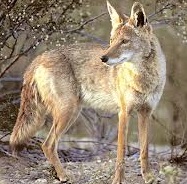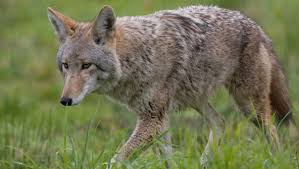The coyote is a canid native to Central and North America. It is smaller than its close relative, the gray
wolf and slightly smaller than its other close relatives, the eastern wolf and the red wolf, being roughly
the North American equivalent to the Old World golden jackal, though it is larger and more predatory. It is
listed as least concern by the International Union for Conservation of Nature (IUCN), due to its wide
distribution and abundance throughout North America, southwards through Mexico and into Central America.
The species is versatile and able to adapt to environments modified by humans. As human activity has altered
the landscape, the coyote's range has expanded. In 2013, coyotes were sighted in eastern Panama (across the
Panama Canal from their home range) for the first time. The coyote is more closely related to the common
ancestor of wolves and other canids (more "basal") than the gray wolf. As of 2005, 19 coyote subspecies are
recognized.
The average male coyote weighs 8 to 20 kilograms (18 to 44 lb) and the average female 7 to 18 kilograms (15
to 40 lb). Their fur color is predominantly light gray and red or fulvous interspersed with black and white,
though it varies somewhat with geography. It is highly flexible in social organization, living either in a
family unit or in loosely knit packs of unrelated individuals. It has a varied diet consisting primarily of
animal meat, including deer, rabbits, hares, rodents, birds, reptiles, amphibians, fish, and invertebrates,
though it may also eat fruits and vegetables on occasion. The coyote's characteristic vocalization is a howl
made by solitary individuals. Humans aside, cougars and gray wolves are the coyote's only serious enemies.
Nevertheless, coyotes do sometimes mate with gray, eastern or red wolves, producing hybrids colloquially
called "coywolves". In northeastern United States and eastern Canada, a larger species of coyote (although
still smaller than the three types of wolves), called the eastern coyote is the result on various historical
and recent mating of the various types of wolves and coyotes. Most recent studies show that most wolves
contain some degree of coyote DNA.
The coyote is a prominent character in Native American folklore, mainly in the Southwestern United States and
Mexico, usually depicted as a trickster that alternately assumes the form of an actual coyote or a man. As
with other trickster figures, the coyote uses deception and humor to rebel against social conventions. The
animal was especially respected in Mesoamerican cosmology as a symbol of military might. After the European
colonization of the Americas, it was reviled in Anglo-American culture as a cowardly and untrustworthy
animal. Unlike wolves (gray, eastern or red), which have undergone an improvement of their public image,
attitudes towards the coyote remain largely negative.
Description
Coyote males average 8 to 20 kg (18 to 44 lb) in weight, while females average 7 to 18 kg (15 to 40 lb),
though size varies geographically. Northern subspecies, which average 18 kg (40 lb), tend to grow larger
than the southern subspecies of Mexico, which average 11.5 kg (25 lb). Body length ranges on average from 1
to 1.35 m (3 ft 3 in to 4 ft 5 in), and tail length 40 cm (16 in), with females being shorter in both body
length and height. The largest coyote on record was a male killed near Afton, Wyoming on November 19, 1937,
which measured 1.5 m (4 ft 11 in) from nose to tail, and weighed 34 kg (75 lb). Scent glands are located at
the upper side of the base of the tail and are a bluish-black color.
The color and texture of the coyote's fur varies somewhat geographically. The hair's predominant color is
light gray and red or fulvous, interspersed around the body with black and white. Coyotes living at high
elevations tend to have more black and gray shades than their desert-dwelling counterparts, which are more
fulvous or whitish-gray. The coyote's fur consists of short, soft underfur and long, coarse guard hairs. The
fur of northern subspecies is longer and denser than in southern forms, with the fur of some Mexican and
Central American forms being almost hispid (bristly). Generally, adult coyotes (including coywolf hybrids)
have a sable coat color, dark neonatal coat color, bushy tail with an active supracaudal gland, and white
facial mask. Albinism is extremely rare in coyotes; out of a total of 750,000 coyotes harvested by federal
and cooperative hunters between March 22, 1938, and June 30, 1945, only two were albinos.
The coyote is typically smaller than the gray wolf, but has longer ears and a larger braincase, as well as a
thinner frame, face, and muzzle. The scent glands are smaller than the gray wolf's, but are the same color.
Its fur color variation is much less varied than that of a wolf. The coyote also carries its tail downwards
when running or walking, rather than horizontally as the wolf does.
Coyote tracks can be distinguished from those of dogs by their more elongated, less rounded shape. Unlike
dogs, the upper canines of coyotes extends past the mental foramina.
Habitat
Prior to the near extermination of wolves and cougars, the coyote was most numerous in grasslands inhabited
by bison, antelope, elk, and other deer, doing particularly well in short-grass areas with prairie dogs,
though it was just as much at home in semiarid areas with sagebrush and jackrabbits or in deserts inhabited
by cactus, kangaroo rats, and rattlesnakes. As long as it was not in direct competition with the wolf, the
coyote ranged from the Sonoran Desert to the alpine regions of adjoining mountains or the plains and
mountainous areas of Alberta. With the extermination of the wolf, the coyote's range expanded to encompass
broken forests from the tropics of Guatemala and the northern slope of Alaska.
Coyotes walk around 5-16 kilometres (3.1-9.9 mi) per day, often along trails such as logging roads and paths;
they may use iced-over rivers as travel routes in winter. They are often crepuscular, being more active
around evening and the beginning of the night than during the day. Like many canids, coyotes are competent
swimmers, reported to be able to travel at least 0.8 kilometres (0.50 mi) across water.
Diet

The coyote is roughly the North American equivalent to the Old World golden jackal. Likewise, the coyote is
highly versatile in its choice of food, but is primarily carnivorous, with 90% of its diet consisting of
animal meat. Prey species include bison, deer, sheep, rabbits, rodents, birds, amphibians (except toads),
lizards, snakes, fish, crustaceans, and insects. Coyotes may be picky over the prey they target, as animals
such as shrews, moles, and brown rats do not occur in their diet in proportion to their numbers. More
unusual prey include fishers, young black bear cubs, harp seals and rattlesnakes. Coyotes kill rattlesnakes
mostly for food (but also to protect their pups at their dens) by teasing the snakes until they stretch out
and then biting their heads and snapping and shaking the snakes. In Death Valley, coyotes may consume great
quantities of hawkmoth caterpillars or beetles in the spring flowering months. Although coyotes prefer fresh
meat, they will scavenge when the opportunity presents itself. Excluding the insects, fruit, and grass eaten,
the coyote requires an estimated 600 g (1.3 lb) of food daily, or 250 kg (550 lb) annually. The coyote
readily cannibalizes the carcasses of conspecifics, with coyote fat having been successfully used by coyote
hunters as a lure or poisoned bait. The coyote's winter diet consists mainly of large ungulate carcasses,
with very little plant matter. Rodent prey increases in importance during the spring, summer, and fall.
The coyote feeds on a variety of different produce, including blackberries, blueberries, peaches, pears,
apples, prickly pears, chapotes, persimmons, peanuts, watermelons, cantaloupes, and carrots. During the
winter and early spring, the coyote eats large quantities of grass, such as green wheat blades. It
sometimes eats unusual items such as cotton cake, soybean meal, domestic animal droppings, beans, and
cultivated grain such as corn, wheat, and sorghum.
Hunting and feeding behaviors
While the popular consensus is that olfaction is very important for hunting, two studies that experimentally
investigated the role of olfactory, auditory, and visual cues found that visual cues are the most important
ones for hunting in red foxes and coyotes.
When hunting large prey, the coyote often works in pairs or small groups. Success in killing large ungulates
depends on factors such as snow depth and crust density. Younger animals usually avoid participating in such
hunts, with the breeding pair typically doing most of the work. Unlike the wolf, which attacks large prey
from the rear, the coyote approaches from the front, lacerating its prey's head and throat. Like other
canids, the coyote caches excess food. Coyotes catch mouse-sized rodents by pouncing, whereas ground
squirrels are chased. Although coyotes can live in large groups, small prey is typically caught singly.
Coyotes have been observed to kill porcupines in pairs, using their paws to flip the rodents on their backs,
then attacking the soft underbelly. Only old and experienced coyotes can successfully prey on porcupines,
with many predation attempts by young coyotes resulting in them being injured by their prey's quills.
Coyotes sometimes urinate on their food, possibly to claim ownership over it.
Coyotes may occasionally form mutualistic hunting relationships with American badgers, assisting each other
in digging up rodent prey. The relationship between the two species may occasionally border on apparent
"friendship", as some coyotes have been observed laying their heads on their badger companions or licking
their faces without protest. The amicable interactions between coyotes and badgers were known to
pre-Columbian civilizations, as shown on a Mexican jar dated to 1250-1300 CE depicting the relationship
between the two.








